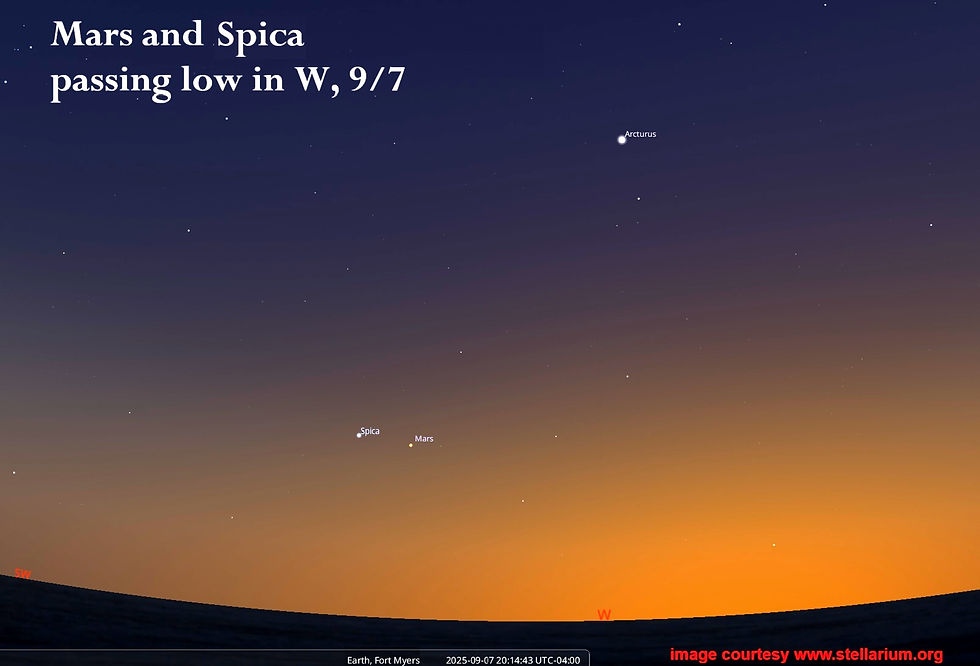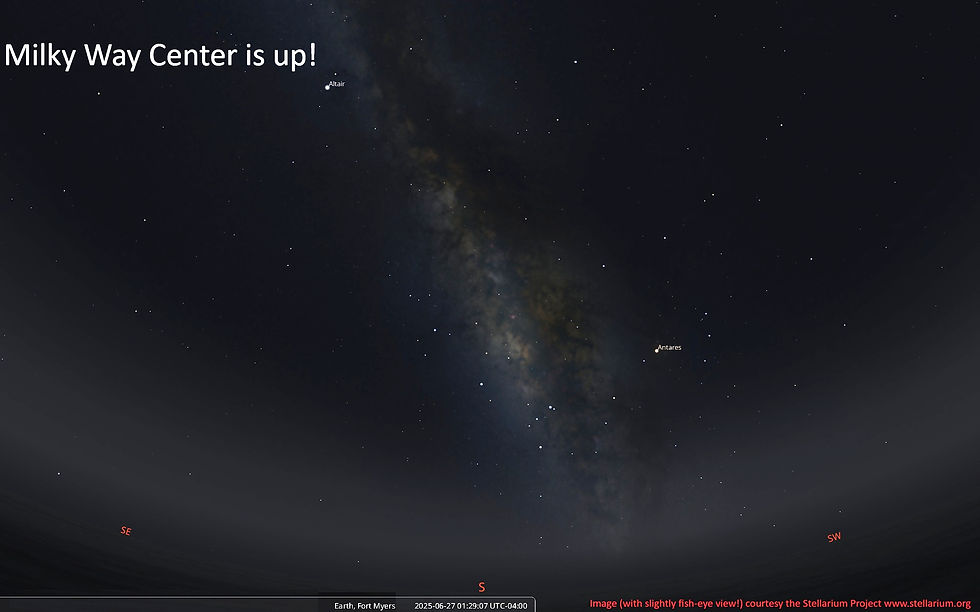What's Up in SW FL Skies: September "eclipse season" and Equinox, Saturn still mostly edge-on, meteors...
- heather92475
- Sep 7
- 4 min read

Moon Phases
Sept 2025 Oct 2025 Nov 2025
Full 3Q New 1Q Full 3Q New 1Q Full 3Q New 1Q
7 14 21 29 7 13 21 29 5 12 20 28
Autumnal Equinox September 22 and the Eclipses That Aren't For Us! September 2025 features a spectacular total lunar eclipse that will not be visible from Florida, alas - the Moon will enter Earth's shadow on September 7th well before nightfall in the Americas and be out of Earth's shadow by mid-afternoon Florida time. Since the full moon rises as the Sun sets, we won't see any of the eclipse. But this alignment means that the Earth-Moon system is in an "eclipse season" and in fact during the next new moon (Sept 21), if you happened to be deep in the southern hemisphere you might catch a partial solar eclipse. That will happen one day before the September Equinox on September 22, the day when the Earth's axial tilt is perpendicular to the Earth-Sun line so that the day and night are of equal length (happens twice a year: Vernal (spring) and Autumnal equinoxes).
September Meteor Showers: The Aurigid meteor shower peaks around September 1st, and the Epsilon Perseids peak on September 9th. Both are what are called "minor showers," and there may even be some leftover regular Perseid meteors into the first week of September, so your chances of spotting a meteor in the late-night skies are not zero, but neither are they phenomenally good!
Planets: Sunset, All Night and Dawn
Mars is in the western evening sky at the beginning of September. Just after sunset on September 7th, reddish Mars and the blue-white star Spica will be side-by-side just above the west-southwestern (WSW) horizon. Mars is the one to the right, and not quite as bright as Spica! In the days following that, Mars will appear to cross from right to left above Spica as you view them from one evening to the next, and the sun will be setting a little earlier each day. On September 23rd, the very thin crescent Moon will be right beside Spica just as the sun sets and for a little while after - around 8 pm! The next night, the crescent moon will be just a little fuller and will be passing a bit farther to the left of Mars. Because of that apparent right-to-left drift of Mars (really N to S), the planet Mars will be visible just after sunset right into the second week of October.
Saturn rises pretty close to sunset this month - it is approaching "opposition" - meaning opposite the Sun in Earth's sky. It will reach opposition on September 21st. This is as close as we get to Saturn in the course of our orbit around the Sun - and right now, Saturn is kind of interesting as we are in a "ring-crossing year" - the rings are nearly edge-on and so can be very hard to discern telescopically - unusual appearance for our solar system's finest-ringed planet! around 9 pm on the 8th, the full moon (well, a day past full officially!) will rise just to the left of Saturn as you gaze at the eastern horizon - a pretty sight! This also means Saturn will be visible all night in September.
At the start of September, Jupiter, Venus and Mercury are lined up above the predawn eastern horizon around 06:20, pointing toward where the Sun will be coming up, but by the second week of September, Mercury will be buried in sunrise-light, and Venus will be appearing to pull toward the horizon relative to Jupiter. On the morning of September 19th, the bright planet Venus, the thin waning crescent moon and the bright star Regulus will be very close together in the sky - a lovely sight, worth getting out at 06:30 and staring toward the eastern horizon!
Stars of Autumn
In September's early evening sky, you can observe right overhead after it's fully dark the Summer Triangle (Vega in Lyra, Deneb in Cygnus, and Altair in Aquila). Each of the three stars of the Summer Triangle is the brightest in its respective constellation. The "W" of Cassiopeia will be visible in the northeast, and the Little Dipper. Looking eastward before dawn, you will easily spot the three stars of Orion's belt pointing the way to the bright "Big Dog" star Sirius, with "Little Dog" star Procyon to the north of it, and Jupiter traipsing through Gemini not far from Castor and Pollux, the "twin stars."
Planetarium
Each day we are open, we show two different planetarium shows, and odd day shows are different from even-day shows, so there are four different shows each month, that alternate two-and-two. Special events are at our Events link, and daily schedule and show descriptions can be accessed by clicking on this link. On Sundays (the "Science Sundays" extra show), there's an additional "audience choice" show at 3:15, and typically on the First Sunday of each month we have a Sensory Sunday special show at 10:30 am, and most months we also have a Planetarium Premiere on the third Wednesday at 7 pm, so you have the potential to see ten different shows in the course of the month. The whole nature center, planetarium, butterfly aviary, raptor aviary and trails complex is open six days per week, closed Mondays. Often a staff member (Todd Sherman is our Planetarium Supervisor and does most shows on weekdays) or docent presenter will present live night sky talks along with our recorded shows: ask if you want a special one! Hoping to see you soon at the Center!
-- Heather Preston, Planetarium Director Emerita





In Geometry Dash's complex rhythmic levels, sound acts as a guide, helping players recognize when to pop up or change states.
The sole press-start variant of the Geometry Dash series with a winter theme is geometry dash subzero. Begin your thrilling leaps with seven geometric shapes by joining today!
Enter Human Expenditure Program, a psychological horror simulation that traps Harvey in endless suffering. Eun-Mi erases his memory each morning, creating a chilling cycle that players must witness.
if you want a special one! Hoping to see you soon at the Center! This reminds me of Friday Night Funkin, where you can enjoy fun and challenging music performances on weekends. A great way to unwind and explore!
Take on the ultimate sports challenge with Basket Random. The game features a variety of creative levels, dynamic music, and customizable icons.